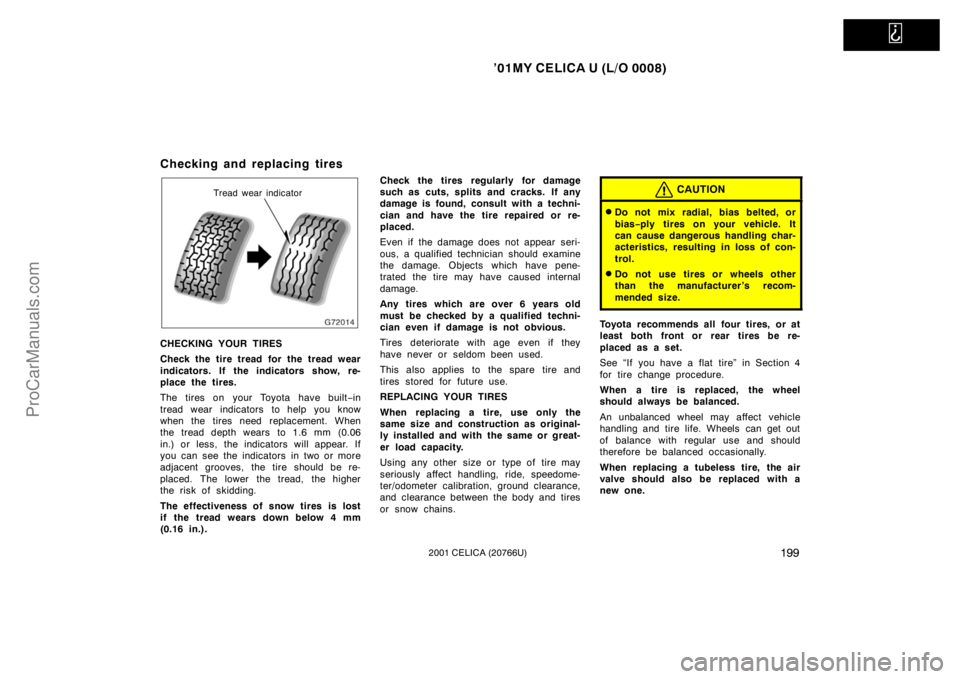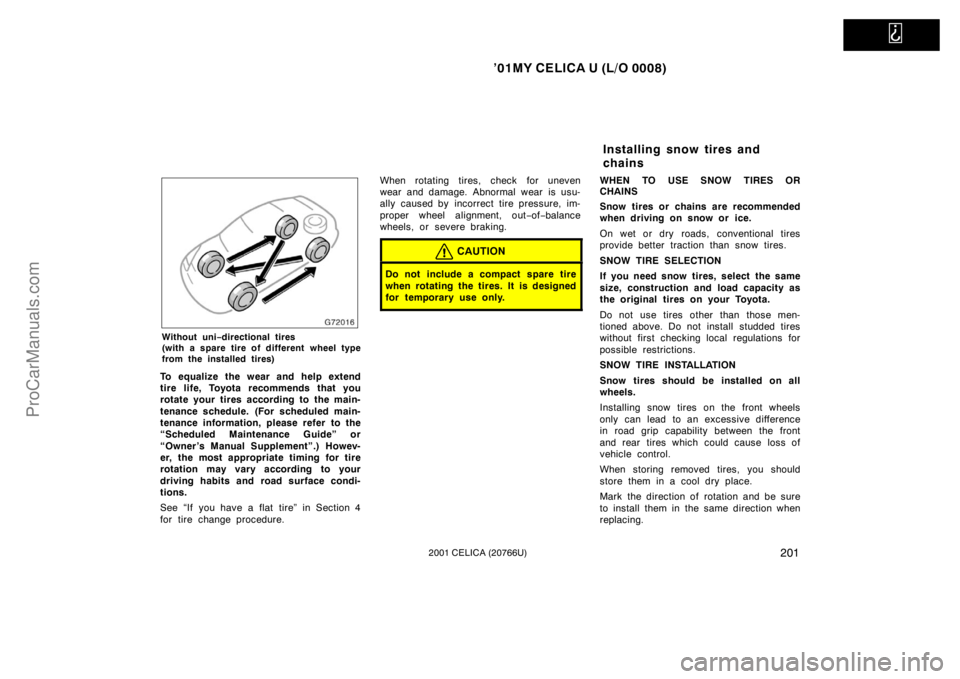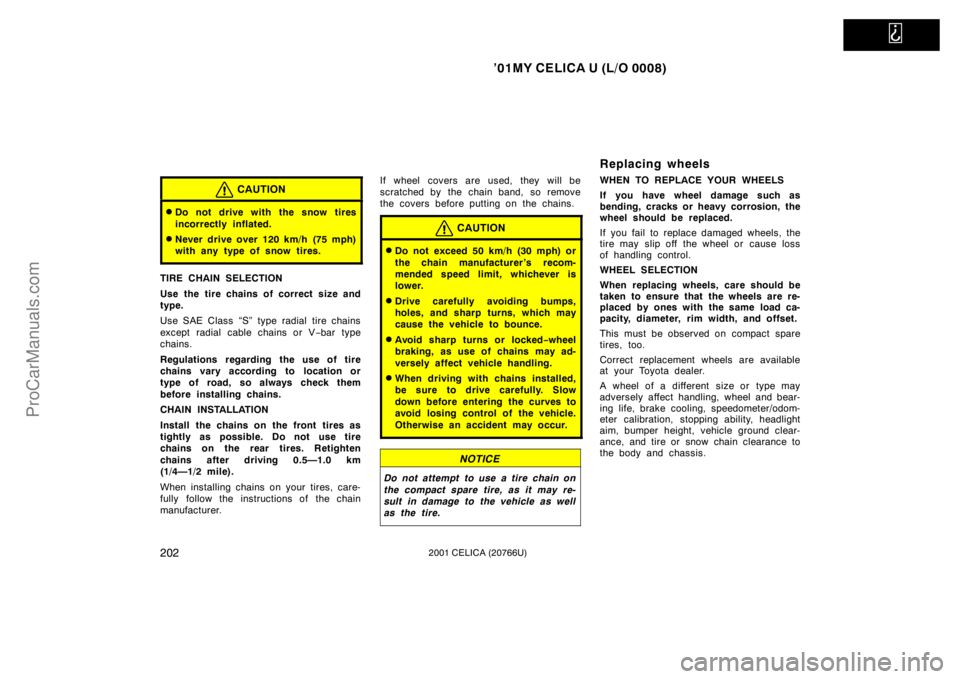Page 204 of 240

’01MY CELICA U (L/O 0008)
1992001 CELICA (20766U)
Checking and replacing tires
Tread wear indicator
CHECKING YOUR TIRES
Check the tire tread for the tread wear
indicators. If the indicators show, re-
place the tires.
The tires on your Toyota have built−in
tread wear indicators to help you know
when the tires need replacement. When
the tread depth wears to 1.6 mm (0.06
in.) or less, the indicators will appear. If
you can see the indicators in two or more
adjacent grooves, the tire should be re-
placed. The lower the tread, the higher
the risk of skidding.
The effectiveness of snow tires is lost
if the tread wears down below 4 mm
(0.16 in.). Check the tires regularly for damage
such as cuts, splits and cracks. If any
damage is found, consult with a techni-
cian and have the tire repaired or re-
placed.
Even if the damage does not appear seri-
ous, a qualified technician should examine
the damage. Objects which have pene-
trated the tire may have caused internal
damage.
Any tires which are over 6 years old
must be checked by a qualified techni-
cian even if damage is not obvious.
Tires deteriorate with age even if they
have never or seldom been used.
This also applies to the spare tire and
tires stored for future use.
REPLACING YOUR TIRES
When replacing a tire, use only the
same size and construction as original-
ly installed and with the same or great-
er load capacity.
Using any other size or type of tire may
seriously affect handling, ride, speedome-
ter/odometer calibration, ground clearance,
and clearance between the body and tires
or snow chains.
CAUTION
�Do not mix radial, bias belted, or
bias
−ply tires on your vehicle. It
can cause dangerous handling char-
acteristics, resulting in loss of con-
trol.
�Do not use tires or wheels other
than the manufacturer ’s recom-
mended size.
Toyota recommends all four tires, or at
least both front or rear tires be re-
placed as a set.
See “If you have a flat tire” in Section 4
for tire change procedure.
When a tire is replaced, the wheel
should always be balanced.
An unbalanced wheel may affect vehicle
handling and tire life. Wheels can get out
of balance with regular use and should
therefore be balanced occasionally.
When replacing a tubeless tire, the air
valve should also be replaced with a
new one.
ProCarManuals.com
Page 205 of 240
’01MY CELICA U (L/O 0008)
2002001 CELICA (20766U)
Rotating tires
Turning direction
Turning direction indicator (type A)
Turning direction
Turning direction indicator (type B)
If a turning indicator is marked on your
tires, you have uni −directional tires. Be-
fore rotating, check whether your tires
are uni −directional before rotating them.
Using tires on the wrong side of the
vehicle will impair tire performance.
See the following instructions for how to
rotate your tires correctly.
With uni −directional tires
Without uni −directional tires
(with a spare tire of the same wheel type
as the installed tires)
ProCarManuals.com
Page 206 of 240

’01MY CELICA U (L/O 0008)
2012001 CELICA (20766U)
Without uni−directional tires
(with a spare tire of different wheel type
from the installed tires)
To equalize the wear and help extend
tire life, Toyota recommends that you
rotate your tires according to the main-
tenance schedule. (For scheduled main-
tenance information, please refer to the
“Scheduled Maintenance Guide” or
“Owner ’s Manual Supplement”.) Howev-
er, the most appropriate timing for tire
rotation may vary according to your
driving habits and road surface condi-
tions.
See “If you have a flat tire” in Section 4
for tire change procedure. When rotating tires, check for uneven
wear and damage. Abnormal wear is usu-
ally caused by incorrect tire pressure, im-
proper wheel alignment, out
−of −balance
wheels, or severe braking.
CAUTION
Do not include a compact spare tire
when rotating the tires. It is designed
for temporary use only.
WHEN TO USE SNOW TIRES OR
CHAINS
Snow tires or chains are recommended
when driving on snow or ice.
On wet or dry roads, conventional tires
provide better traction than snow tires.
SNOW TIRE SELECTION
If you need snow tires, select the same
size, construction and load capacity as
the original tires on your Toyota.
Do not use tires other than those men-
tioned above. Do not install studded tires
without first checking local regulations for
possible restrictions.
SNOW TIRE INSTALLATION
Snow tires should be installed on all
wheels.
Installing snow tires on the front wheels
only can lead to an excessive difference
in road grip capability between the front
and rear tires which could cause loss of
vehicle control.
When storing removed tires, you should
store them in a cool dry place.
Mark the direction of rotation and be sure
to install them in the same direction when
replacing.
Installing snow tires and
chains
ProCarManuals.com
Page 207 of 240

’01MY CELICA U (L/O 0008)
2022001 CELICA (20766U)
CAUTION
�Do not drive with the snow tires
incorrectly inflated.
�Never drive over 120 km/h (75 mph)
with any type of snow tires.
TIRE CHAIN SELECTION
Use the tire chains of correct size and
type.
Use SAE Class “S” type radial tire chains
except radial cable chains or V−bar type
chains.
Regulations regarding the use of tire
chains vary according to location or
type of road, so always check them
before installing chains.
CHAIN INSTALLATION
Install the chains on the front tires as
tightly as possible. Do not use tire
chains on the rear tires. Retighten
chains after driving 0.5—1.0 km
(1/4—1/2 mile).
When installing chains on your tires, care-
fully follow the instructions of the chain
manufacturer. If wheel covers are used, they will be
scratched by the chain band, so remove
the covers before putting on the chains.
CAUTION
�Do not exceed 50 km/h (30 mph) or
the chain manufacturer ’s recom-
mended speed limit, whichever is
lower.
�Drive carefully avoiding bumps,
holes, and sharp turns, which may
cause the vehicle to bounce.
�Avoid sharp turns or locked−
wheel
braking, as use of chains may ad-
versely affect vehicle handling.
�When driving with chains installed,
be sure to drive carefully. Slow
down before entering the curves to
avoid losing control of the vehicle.
Otherwise an accident may occur.
NOTICE
Do not attempt to use a tire chain on
the compact spare tire, as it may re-
sult in damage to the vehicle as well
as the tire.
Replacing wheels
WHEN TO REPLACE YOUR WHEELS
If you have wheel damage such as
bending, cracks or heavy corrosion, the
wheel should be replaced.
If you fail to replace damaged wheels, the
tire may slip off the wheel or cause loss
of handling control.
WHEEL SELECTION
When replacing wheels, care should be
taken to ensure that the wheels are re-
placed by ones with the same load ca-
pacity, diameter, rim width, and offset.
This must be observed on compact spare
tires, too.
Correct replacement wheels are available
at your Toyota dealer.
A wheel of a different size or type may
adversely affect handling, wheel and bear-
ing life, brake cooling, speedometer/odom-
eter calibration, stopping ability, headlight
aim, bumper height, vehicle ground clear-
ance, and tire or snow chain clearance to
the body and chassis.
ProCarManuals.com
Page 230 of 240
’01MY CELICA U (L/O 0008)
2252001 CELICA (20766U)
Tires
Tire size and pressure:
Except spare tireModel
Tire size
Tire pressure
kPa (kgf/cm2 or bar, psi)Wheel size
FrontRear
1ZZ −FE engine195/60R15 88H210 (2.1, 29)210 (2.1, 29)15 �61/2JJ
P195/60R15 87H210 (2.1, 29)210 (2.1, 29)15 �61/2JJ
2ZZ −GE engine
205/55R15 87V220 (2.2, 32)220 (2.2, 32)15 �61/2JJ
P205/55R15 87V220 (2.2, 32)220 (2.2, 32)15 �61/2JJ
205/50R16 87V220 (2.2, 32)220 (2.2, 32)16 �61/2JJ
Spare tire
Tire sizeTire pressure kPa (kgf/cm2 or bar, psi)Wheel size
U.S.AT125/70D16 96M420 (4.2, 60)16 �4T
CanadaSame as original tire
Wheel nut torque, N·m (kgf·m, ft·Ibf):
103 (10.5, 76)
NOTE: For a complete information on tires (e.g. replacing tires or replacing wheels), see “Checking tire pressure” through “Alum inum
wheel precautions” in Section 7 −2.
ProCarManuals.com